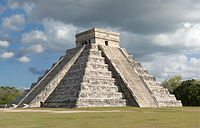
Photo from wikipedia
Abstract Interdisciplinary research at the interface of linguistics and archaeology is often concerned with relationships between archaeological cultures and language families, their subgroups, or their proto-languages. This often makes the… Click to show full abstract
Abstract Interdisciplinary research at the interface of linguistics and archaeology is often concerned with relationships between archaeological cultures and language families, their subgroups, or their proto-languages. This often makes the problematic assumption of a one-to-one correspondence between groupings from the two disciplines. Here, I show how evidence from Northern Peru, a region which once hosted a myriad of well-differentiated local languages and an equally multifaceted sequence of more or less localized pre-Hispanic cultures, can contribute complementary perspectives to existing models. After providing some summary background information, I discuss two regions of Northern Peru –the North Coast and the cloud forests of Chachapoyas– which both exhibit linguistic divisions that correspond to differences in the archaeological record within what has (traditionally) been taken to constitute overarching archaeological cultures; differences in language and cultural expression may both be interpretable as indexes of different pre-Hispanic social, ethnic, or political identities and allegiances. These cases underscore that one-to-one mappings between languages and archaeological cultures (or their expansions) may in some cases be inadequate.
Journal Title: Language Sciences
Year Published: 2021
Link to full text (if available)
Share on Social Media: Sign Up to like & get
recommendations!